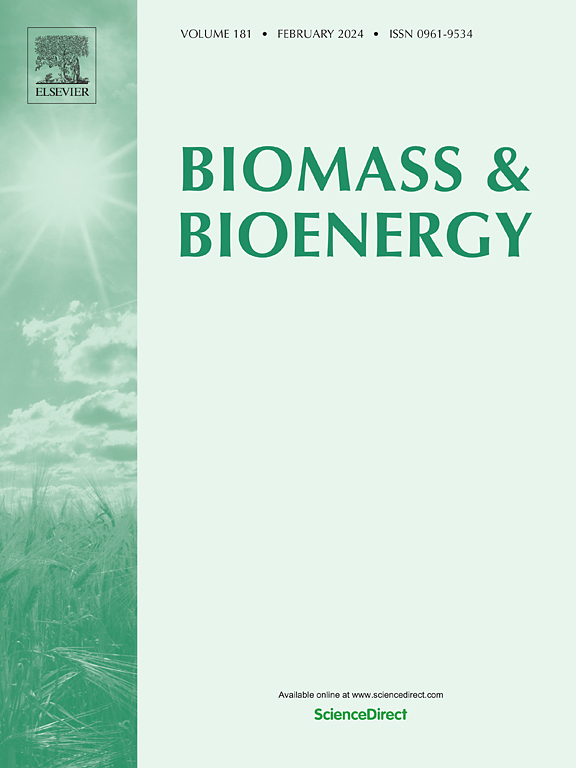Optimization of crop planting structure based on agricultural water-energy-food-carbon nexus index: A case study of the Tuojiang river basin
IF 5.8
2区 生物学
Q1 AGRICULTURAL ENGINEERING
引用次数: 0
Abstract
Addressing the escalating tensions between low-carbon transition, food security, energy provision, and resource limitations presents a pivotal challenge for achieving sustainable agricultural modernization. This research advances a novel Water-Energy-Food-Carbon Nexus Index (WEFCNI) framework that systematically incorporates carbon emission into traditional agricultural nexus analysis, enabling quantitative assessment of synergistic relationships among these four critical subsystems. Building upon this foundation, we develop an innovative multi-objective optimization model that simultaneously considers bioenergy potential and nexus system coordination, designed to optimize resource allocation. The proposed methodology undergoes rigorous empirical validation through application in China's Tuojiang River Basin, demonstrating its effectiveness in guiding sustainable agricultural planning. Results indicate that the average WEFCNI values for crops in the basin ranged between 0.2 and 0.7 from 2011 to 2022, suggesting substantial potential for enhancing coupled coordination. The total bioenergy production from crop residues reached 16379.62 during this period, with rice straw contributing 41.34 % of the total yield. The optimization model effectively increased crop yields and bioenergy production. At the same time, it achieved remarkable effects in energy conservation and carbon reduction. The carbon emissions decreased by 275.98 , and energy consumption decreased by 411.41 . This study's model provides a useful reference for managing agricultural resources sustainably.
基于农业水-能-粮-碳联系指数的作物种植结构优化——以沱江流域为例
解决低碳转型、粮食安全、能源供应和资源限制之间不断升级的紧张关系,是实现可持续农业现代化的关键挑战。本研究提出了一种新的水-能源-食物-碳联系指数(WEFCNI)框架,该框架将碳排放系统地纳入传统的农业联系分析中,从而能够定量评估这四个关键子系统之间的协同关系。在此基础上,我们开发了一个创新的多目标优化模型,同时考虑生物能源潜力和联系系统协调,旨在优化资源配置。本文提出的方法在中国沱江流域进行了严格的实证验证,证明了其在指导可持续农业规划方面的有效性。结果表明:2011 - 2022年,流域作物WEFCNI均值在0.2 ~ 0.7之间,具有增强耦合协调的巨大潜力。在此期间,农作物秸秆生物能源总产量达到16379.62 (108MJ),其中秸秆占总产量的41.34%。该优化模型有效地提高了作物产量和生物能源产量。同时,在节能减排方面取得了显著的效果。碳排放量减少275.98 (108kgCO2eq),能耗减少411.41 (108MJ)。该模型为农业资源的可持续管理提供了有益的参考。
本文章由计算机程序翻译,如有差异,请以英文原文为准。
求助全文
约1分钟内获得全文
求助全文
来源期刊

Biomass & Bioenergy
工程技术-能源与燃料
CiteScore
11.50
自引率
3.30%
发文量
258
审稿时长
60 days
期刊介绍:
Biomass & Bioenergy is an international journal publishing original research papers and short communications, review articles and case studies on biological resources, chemical and biological processes, and biomass products for new renewable sources of energy and materials.
The scope of the journal extends to the environmental, management and economic aspects of biomass and bioenergy.
Key areas covered by the journal:
• Biomass: sources, energy crop production processes, genetic improvements, composition. Please note that research on these biomass subjects must be linked directly to bioenergy generation.
• Biological Residues: residues/rests from agricultural production, forestry and plantations (palm, sugar etc), processing industries, and municipal sources (MSW). Papers on the use of biomass residues through innovative processes/technological novelty and/or consideration of feedstock/system sustainability (or unsustainability) are welcomed. However waste treatment processes and pollution control or mitigation which are only tangentially related to bioenergy are not in the scope of the journal, as they are more suited to publications in the environmental arena. Papers that describe conventional waste streams (ie well described in existing literature) that do not empirically address ''new'' added value from the process are not suitable for submission to the journal.
• Bioenergy Processes: fermentations, thermochemical conversions, liquid and gaseous fuels, and petrochemical substitutes
• Bioenergy Utilization: direct combustion, gasification, electricity production, chemical processes, and by-product remediation
• Biomass and the Environment: carbon cycle, the net energy efficiency of bioenergy systems, assessment of sustainability, and biodiversity issues.
 求助内容:
求助内容: 应助结果提醒方式:
应助结果提醒方式:


